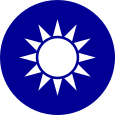
Back الوضع السياسي في تايوان Arabic Estatus políticu de Taiwán AST Taiwan-Konflikt German Estatus político de la República de China Spanish وضعیت سیاسی تایوان Persian Statut de Taïwan French מעמדה הבין-לאומי של טאיוואן HE Status politik Taiwan ID Status politico di Taiwan Italian 台湾問題 Japanese
| Taiwan issue | |||||||||||||||||||||||||
|---|---|---|---|---|---|---|---|---|---|---|---|---|---|---|---|---|---|---|---|---|---|---|---|---|---|
| Traditional Chinese | 臺灣問題 | ||||||||||||||||||||||||
| Simplified Chinese | 台湾问题 | ||||||||||||||||||||||||
| Literal meaning | Taiwan question | ||||||||||||||||||||||||
| |||||||||||||||||||||||||
 |
|---|
|
|
 |
|---|
|
|
The controversy surrounding the political status of Taiwan or the Taiwan issue is an ongoing dispute on the political status of Taiwan, currently controlled by the Republic of China (ROC). This dispute arose in the mid-twentieth century.
Originally based in Mainland China before and during World War II, the ROC government retreated to Taiwan in 1949 after the Chinese Communist Party (CCP) won the Chinese Civil War and established the People's Republic of China (PRC) in mainland China. Since then, the effective jurisdiction of the ROC has been limited to Taiwan, Penghu, Kinmen, Matsu, and smaller islands.
Prior to 1942, the CCP maintained that Taiwan was a separate nation.[1][2] Since its establishment in 1949, the PRC has claimed Taiwan as a province and has refused to establish diplomatic relations with Taiwan. The PRC has additionally not ruled out the use of force in the pursuit of unification.[3] The ROC maintained its claim of being the sole legitimate representative of China and its territory until 1991, when it ceased to regard the CCP as a rebellious group and recognized its jurisdiction over mainland China.[4] The PRC has officially proposed "one country, two systems" as a model for unification, though this has been rejected by the Taiwanese government.[5] Within Taiwan, major political contention has been between parties favoring eventual Chinese unification and promoting a pan-Chinese identity, contrasted with those aspiring to formal international recognition and promoting a Taiwanese identity, though both sides have moderated their positions to broaden their appeal in the 21st century.[6][7]
The PRC includes not formally recognizing the ROC as a prerequisite for establishing diplomatic relations. Internationally, the United Nations and all countries that have diplomatic relations with the PRC handle relations with Taiwan according to their own respective "One China" policies.[8]
- ^ Hsiao, Frank S. T.; Sullivan, Lawrence R. (1979). "The Chinese Communist Party and the Status of Taiwan, 1928-1943". Pacific Affairs. 52 (3): 446. doi:10.2307/2757657. JSTOR 2757657.
- ^ Cite error: The named reference
:3was invoked but never defined (see the help page). - ^ "Archived copy" (PDF). Archived (PDF) from the original on 24 January 2020. Retrieved 19 November 2019.
{{cite web}}: CS1 maint: archived copy as title (link) - ^ Han Cheung (25 April 2021). "Taiwan in Time: The 'communist rebellion' finally ends". Taipei Times. Archived from the original on 22 October 2021. Retrieved 2 July 2022.
...Most importantly, with the repeal of the temporary provisions, the Chinese Communist Party would no longer be seen as a rebel group. "From now on, we will see the Chinese Communist Party as a political entity that controls the mainland region and we will call them the 'mainland authorities' or the 'Chinese Communist authorities'," President Lee said during the press conference
- ^ "Taiwan leader rejects China's 'one country, two systems' offer". Reuters. 10 October 2019. Archived from the original on 6 October 2023. Retrieved 21 September 2023.
- ^ Fell, Dafydd (2006). Party Politics in Taiwan. Routledge. p. 85. ISBN 978-1-134-24021-0.
- ^ Achen, Christopher H.; Wang, T. Y. (2017). "The Taiwan Voter: An Introduction". In Achen, Christopher H.; Wang, T. Y. (eds.). The Taiwan Voter. University of Michigan Press. pp. 1–25. doi:10.3998/mpub.9375036. ISBN 978-0-472-07353-5. pp. 1–2.
- ^ Chong, Ja Ian (9 February 2023). "The Many "One Chinas": Multiple Approaches to Taiwan and China". Carnegie Endowment for International Peace. Archived from the original on 3 May 2023. Retrieved 6 May 2023.
